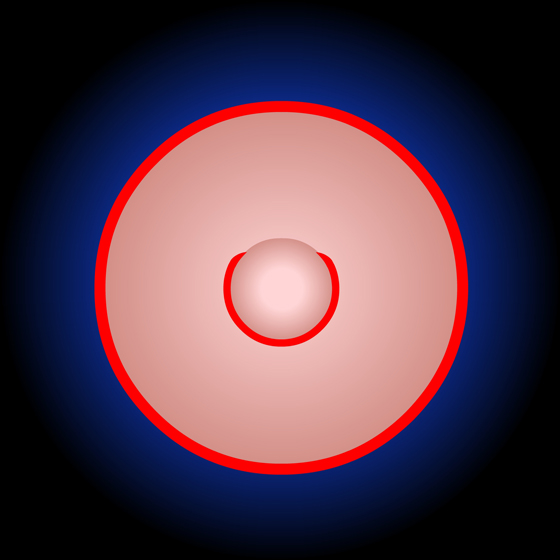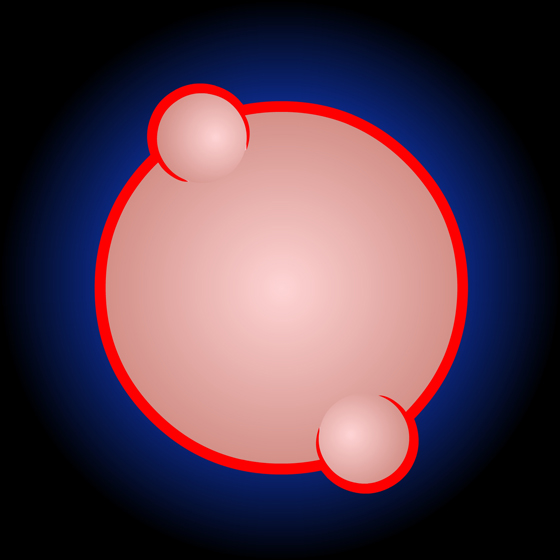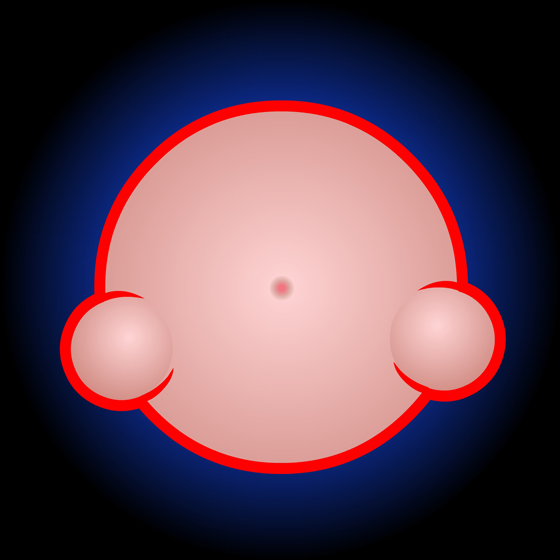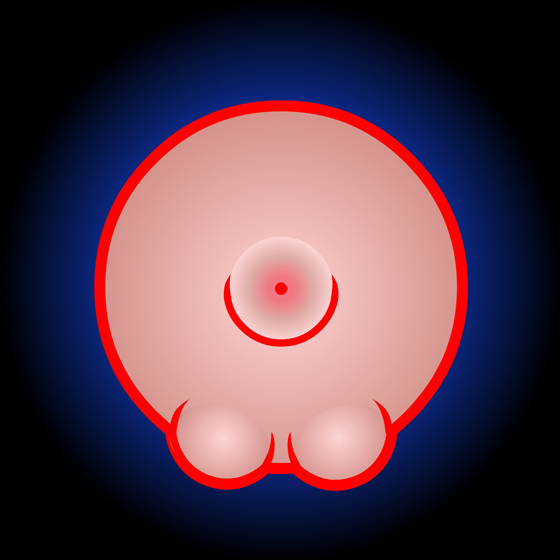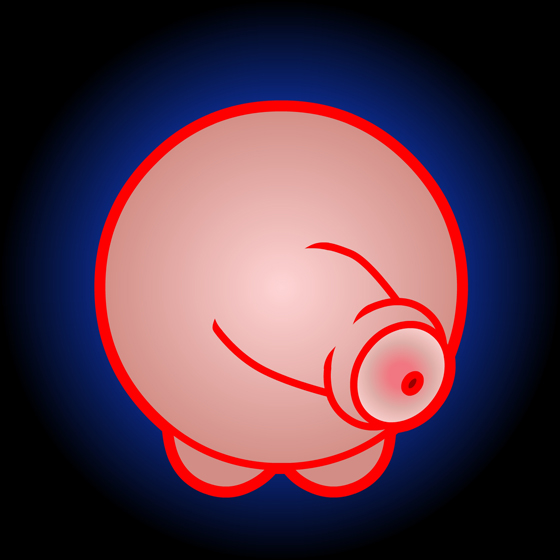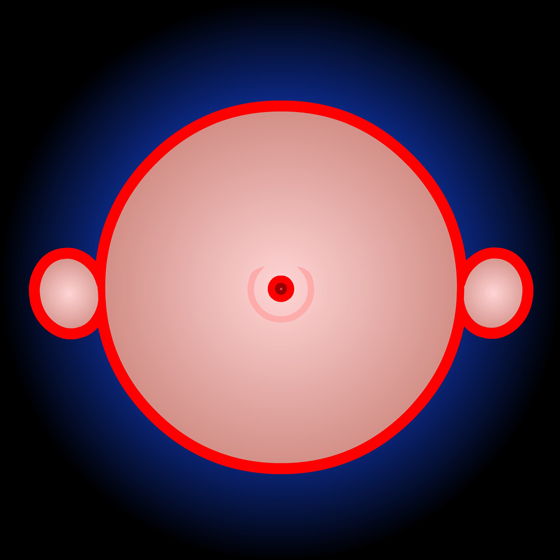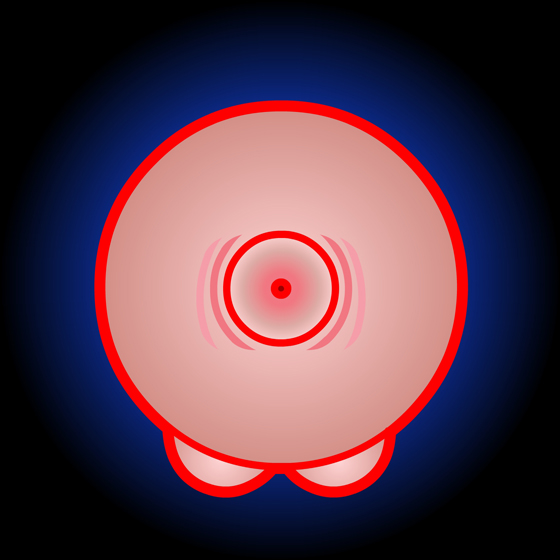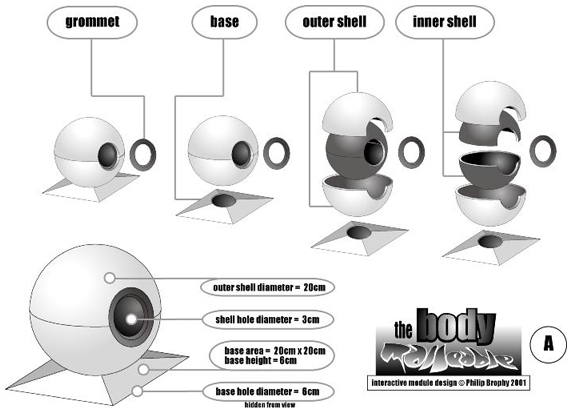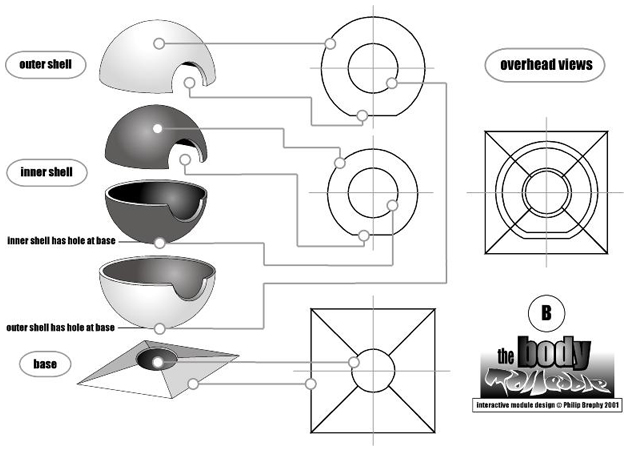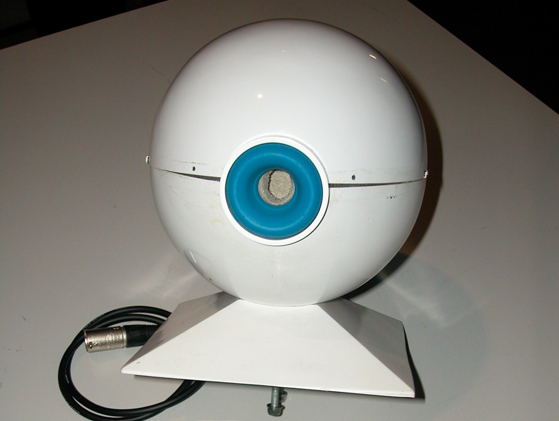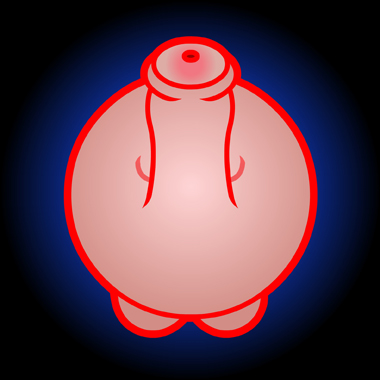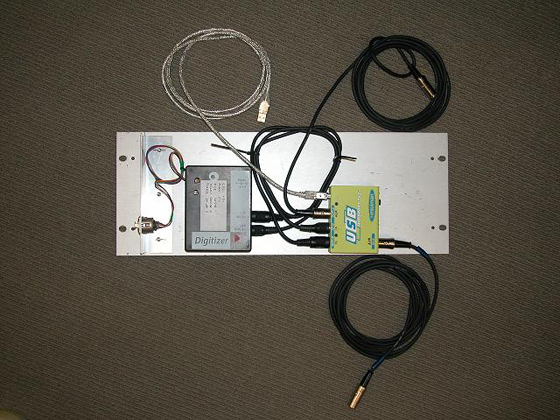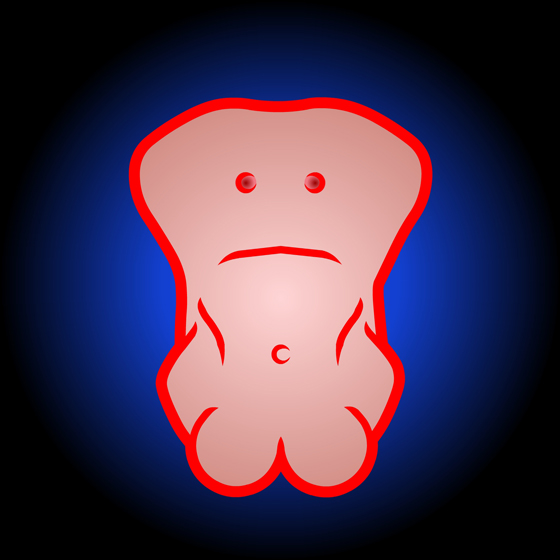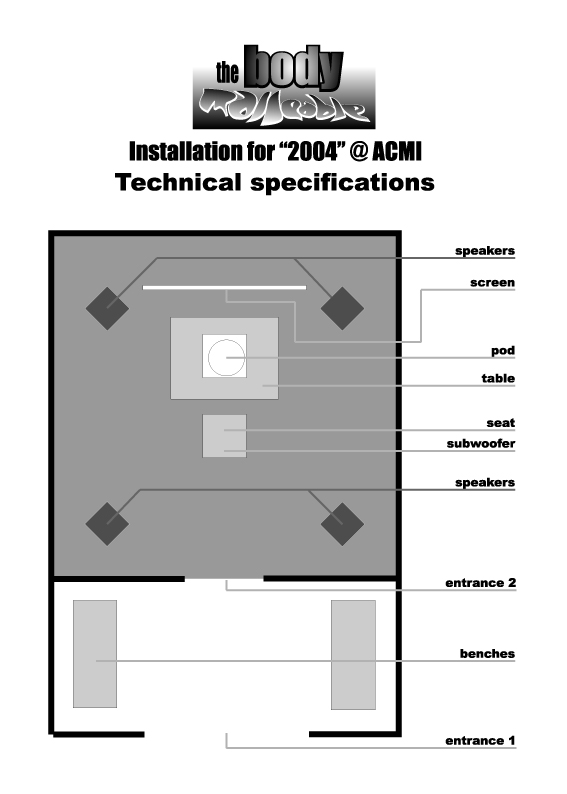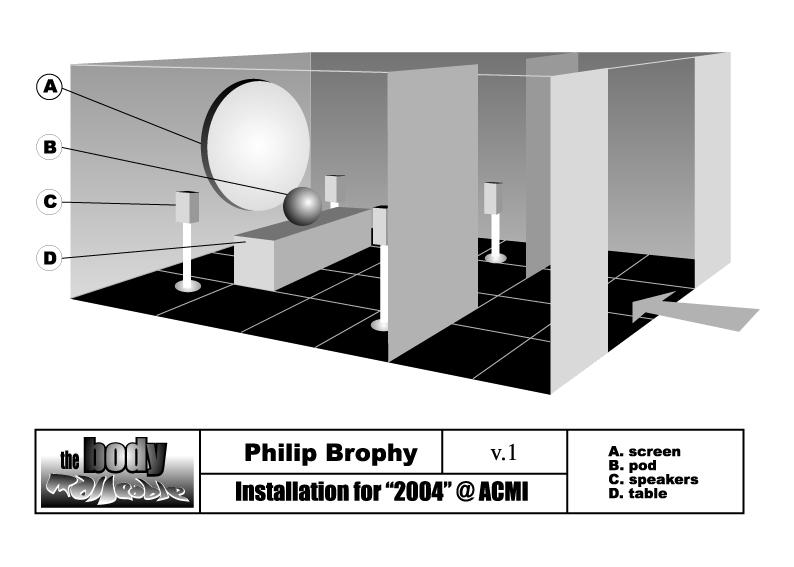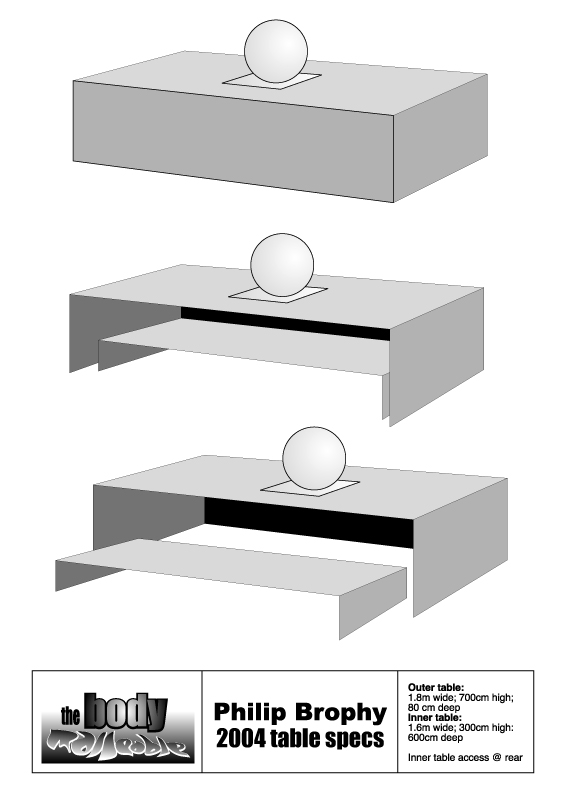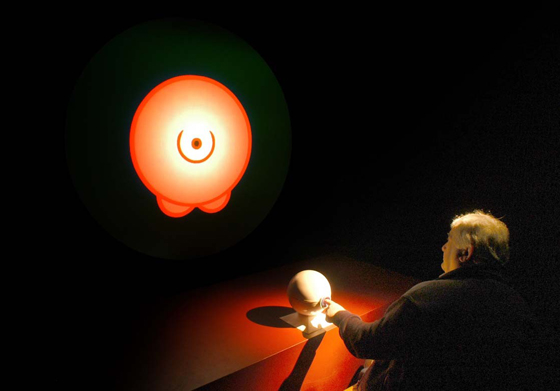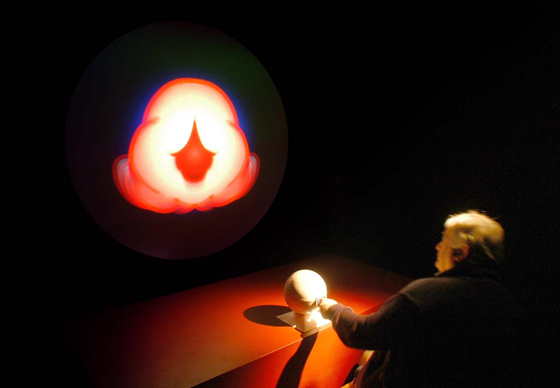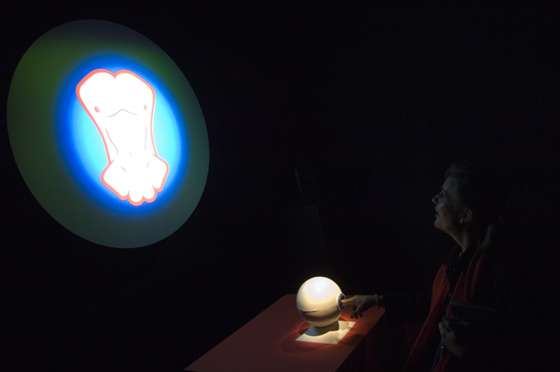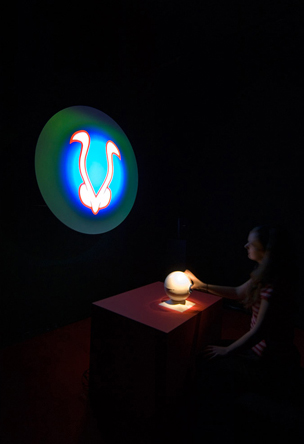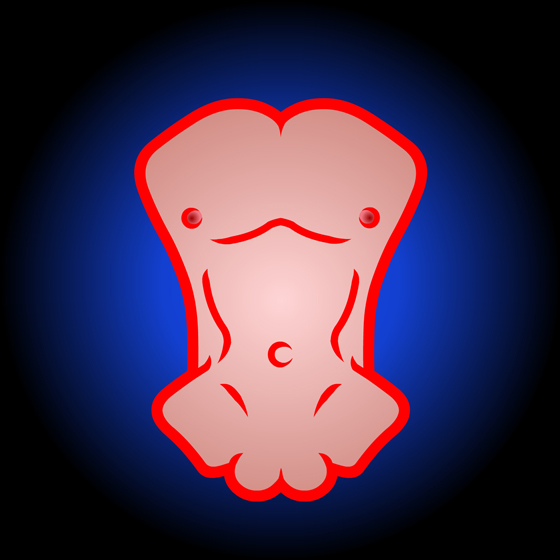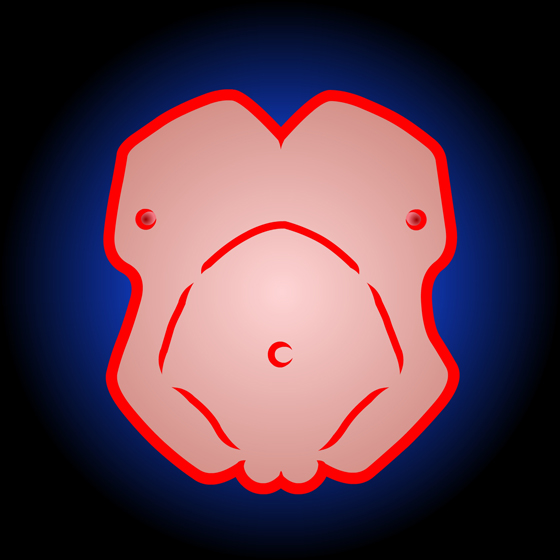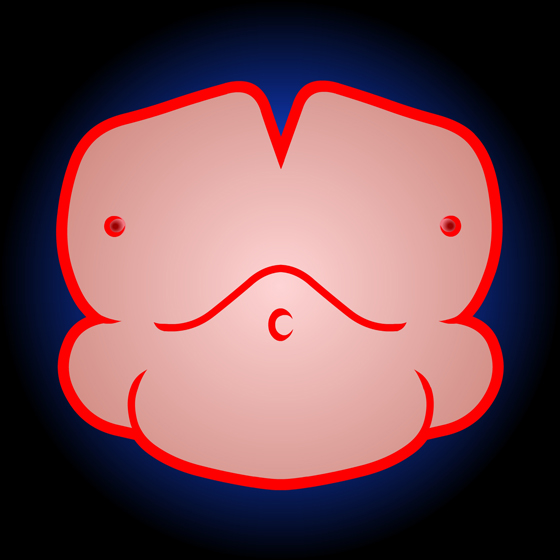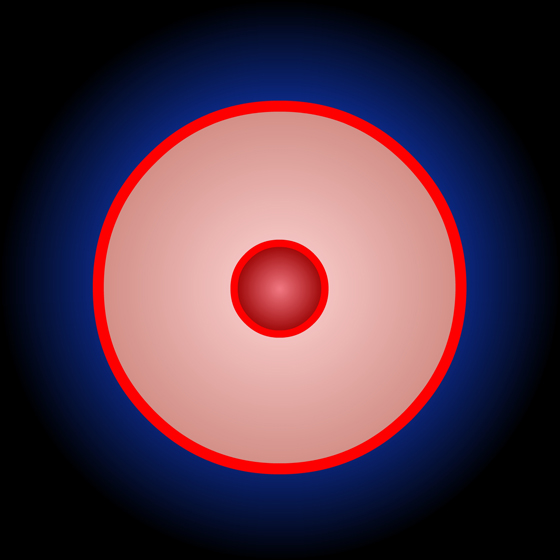Background
The Body Malleable is a small-scale interactive work comprised of digital animation projected into a private darkened space. The user controls the animation and its synchronized audio via a custom-built physical interface.
The Body Malleable was commissioned by the Cinemedia Digital Media Fund in 2002. The invitation was to produce an interactive for the Australian Centre for the Moving Image's permanent collection. The submitted proposal was to produce an interactive that would minimize anything to do with foregrounding interactive media and maximize experience. The aim was particularly concerned with delivering content that did not make a broad statement about interactivity.
The Body Malleable is conceptually shaped by Philip's established themes (bodies, sound, sex, etc.) and is focused on the 'digital penetration' of a single finger. The interactive took the form of a pod ball (about the size of a soccer ball) with a small opening. Placed on a table in front of a suspended screen, the participant sticks their finger into the hole to move through a series of animated images on the screen. 4-channel surround sound accompanies the imagery. Both sound and imagery are wholly controlled by the participant's finger action. The animated images comprise a series of morphing possibilities of body parts, orifices, protrusions and organs. The synchronized soundtrack is constructed from digitally-processed fragments of human vocals.
Selected key-frames © 2004Credits
Concept & direction: Philip Brophy
Images & rendering: Philip Brophy
Animation: Isobel Knowles
Interactive authoring: Casey Rice & Isobel Knowles
Final MAX authoring: Casey Rice
Pod shell design: Philip Brophy & Haima Marriott
Pod shell fabrication: Mother’s Art & Haima Marriott
Pod mechanical engineering design: Anthony Kitchener & Anthony Heap
Pod mechanical construction, maintenance & set-up: Anthony Heap
Sound design: Philip Brophy
MIDI implementation: Casey Rice
Special thanks: Anthony Kitchener of Cash Engineering
Production thanks: Helen Stuckey, Martine Corompt, Cornel Wilczek
ACMI installation thanks: Victoria Lynne, Alexie Glass, Michael Fairleigh
AGNSW installtion thanks: Erica Drew, Natasha Bullock, Brian Blackwell
Artage Bakery installation thanks: Marcus Canning, Ainsley, Yvonne Doherty
National Museum of Art Osaka installation thanks: Yukihiro Hirayoshi & the NMOA staff
Culture Institute Mechelen thanks: Robrecht Ghesquiere, Hugh Lannoot & Erik Desmedt
MONA installation thanks: Nicole Durling, James Dwyer, Adam Meredith & Casey Rice
2011
MONANISM - Museum of Old & New Art, Hobart
Purchased for the MONA collection
2009
ALL THAT IS SOLID MELTS INTO AIR - Cultuursite, Mechelen, Belgium
2007
SKIN - National Museum of Art, Osaka
EROTIC ART PRIZE inaugral invitation work - The Bakery, Perth
2006
ANNE LANDA AWARD - Art Gallery of New South Wales, Sydney
2004
2004: AUSTRALIAN CULTURE NOW - Australian Centre for the Moving Image, Melbourne
Selected key-frames © 2004Overview
Conceptual outline from original proposal
Away from the grand socioeconomic narratives which have written the first chapter of the digital era, the crucial value of digital technologies and their direction within limited lines of interactivity lies not in any way they have reconfigured the individual, but in the ways that they have rendered the body immaterial, invisible and indistinguishable. In an overload of buzzing strobing screens, extruded plastic buttons, blurred anti-aliased scans and crackling waveform samples, everything from a jittery Quicktime of Pamela Anderson on celebrityslut.com to a lo-res jpeg of a carrot on greengrocer.com becomes an instance of distended identification and distanced consumption. As their virtuality collapses into a well of dissimulation, they resemble each other more than they appear differentiated. Far from either touching Pamela’s silicon breast or smelling the acidic bite of genetically-modified carrots, the on-line consumer enjoys a hyper-distancing which serves to increase parafilliac tendencies in the face of abstracted renderings of clear objects of desire.
Viewed from this angle, the fetishization of the virtual is a deluded celebration of the repressed, while the impulse to ‘interact’ – by jerking one’s forefinger to spurt forth a stream of compressed data through optical fibre – is a naïve yet pathological will to penetrate. It is specifically this will to penetrate wombic, vaginal, colonic and penile dimensions that The Body Malleable project addresses. Intended as an outright re-sexualization of the core impulse betwixt the line of interactivity, The Body Malleable targets the denial of psychosexual duplicity in the actioning of interactive design and implementation. Its interactive module accents the insertable dimension rather than the ejaculative trigger points of interaction which govern the ‘touch’ mechanisms of mouses and hot keys. In blunt contrast to the ejaculatory, emissive, streamed and showering exchanges which splatter the flattened screen – itself no more than a ‘vertically prostrate’ vanishing plane – The Body Malleable both accepts the sexual drive behind all acts of interaction and broadens its horizon into a malleable realm of polysexuality.
Selected key-frames © 2004Audience projection from the original proposal
The audience for this project is the same audience that has suffered movies by Steven Spielberg for the last 20 years: anyone from six to sixty-six years old. This work is rated G for gender, PG for post-gender, M for malleable and R for repressed. It is specifically aimed at you, your children and your parents.
The attractions for this work are its simultaneous exploitation of sex and the usability it has for those interested in sexual vicariousness. It is laterally pornographic and as such combines seduction with repulsion; titillation with identification. The humour and novelty of its interface design will provide a safety mechanism for the user to have an actual experience of sexual realignment as he/she/it morphs body shapes and parts in a flux of sexual variables. The lack of identifiable stasis while physically interacting with a module is the crux of The Body Malleable’s interactive experience.
Catalogue statement from the premiere exhibition:
2004 - Australian Culture Now, ACMI
You want to stick your finger in, but once you do, it gets messy. Not with fluids, but with form. The internal becomes the external. Dark moist crevices are aerated into protruding spongeforic shapes. Hard becomes soft – grows thin – gets fat. The body becomes a bulbous breathing trail of possibilities for your own body, the body you want, and the body with which to connect. The penile and the vaginal roll and flutter like a series of hot flushes, but they are degendered by their incessant drive to become the other. Bi, gay, straight are social costumes to be left at the door. You are now a slug: socially blind yet sexually primed. The colon and its polysexual route to infinite Otherness beckons you. There is no turning back once the body becomes malleable.
Technical
Digital Animation
The design of the body shapes for the animation was undertaken in order to ascertain the most effective way to articulate the body relative to the actioning of interactivity. This required the design to:
1 . embody an iconic aspect rather than a realistic/3-D appearance;
2 . concentrate less on a recognizable body whole and more on body parts, fragments and components; and
3 . be such these parts, fragments and components could morph through a series of small scale movements.
A new set of elements was thus designed by Philip Brophy to be key frames for the Digital Animation. Each of these key frames were hand drawn; scanned in Photoshop; exported as EPSs; imported into Freehand; drawn as outlines; exported as SWFs; then imported into Flash. In Flash, the images had basic line width and fills assigned to them as part of a ‘model sheet’ protocol to be adhered to in further stages of rendering and outputting. The model sheet was also structured in accordance with a set of 16 sequences (each broken in two halves in preparation for the 'in' and 'out' finger movement required for the Interactive Interface).
The Body Malleable (pod mechanics documentation) 3' 43", stereo mix © 2004Inbetweening of the key frames was then completed in Flash by Isobel Knowles. From the original 128 key frames (42 examples can be seen below) a total of 1.205 frames were created. These frames were then rendered by Philip Brophy with motion gradients as well as customized line points and curvatures required for each individual frame to effect the iconic brushwork suggestive of inked comics (lines tapered to thin points, variance in boldness of outlines, etc.).
The Body Malleable is thus comprised of 32 image sequences, each divided into 2 halves. These sequences contain between 35 to 70 individual frames such as the ones illustrated above. The first half of a sequence plays when the user inserts their finger. Then when the user pushes the soft silicon wall at the end of the colon, the second half of a sequence imperceptibly switches over until the user brings his/her finger back toward the opening of the orifice. Then at that point the first half of the next sequence is imperceptibly triggered.
Selected key-frames © 2004Interface Design
The initial simplistic concept - based on utilizing 'off=the=shelf' componentry - was to reconfigure an alphanumerical keyboard and position all the keys inside a spherical lining inside a ball. The keys would then be covered with a silicon sheet, thin enough to still allow the keys to be flat as pressed by the user. These keys would then be hooked up to an i-cube MIDI converter, which would be used as the means for moving through audio and image via MIDI control in Director. Through an orifice in the ball, the user would push their finger in and 'blindly' feel their way around the keys. After assessing the most effective way to connect the MIDI trigger sheets to an I-Cube interface, it was decided that the inverted spherical zone comprised of deconstructed and reconfigured alphanumerical keyboard parts was not appropriate to the way that MIDI data works as series of 0-127 incremental lines.
The solution to this problem was to envisage the interactive shell still as comprising an orifice-opening, but inside one’s finger now encounters a ‘push-corridor’: a thin tube into which one’s finger slides in and out. At the end of the tube is a sprung rubber contact that presents resistance to one’s finger, forcing one to push one’s finger further into the corridor. This push-corridor works well in being able to process incremental lines of MIDI data, plus its encasement within the physical module is stable and firmly integrated into the shell design. After meetings with Mother’s Art, a conclusive approach was devised to start the first module. This involved a re-think of how to incorporate the push-corridor in replacement of the inverted spherical zone of the original design. The I-Cube software and interface were then adapted to a core fader control (a slide system, not unlike those in audio mixing desks). The interior of the pod was then implemented as a metal tube through which a rod and slug were placed with a spring at one end, creating pressure against the user's finger as it is inserted through the orifice and down the metal tube.
Pod design © 2004After starting to connect theses internal mechanics of the pod to the i-cube and then test some MAX patches that coder Casey Rice supplied, the resulting movement through the sequenced image frames was deemed to be unstable. It became apparent that the slight imprecision in the mechanical design of the interior of the pod generated such a margin of error and physical slop that it would prove problematic for both further coding and – ultimately – stable user interactivity. This involved securing Cash Research Engineering as a subcontractor for a redesign of the internal mechanics of the Physical Interface.
Cash Research Engineering director and chief engineer Anthony Kitchener undertook an analysis of the Physical Interface and proposed a redesign based on keeping the fader as implemented in the original design. He then suggested (a) replacing the metal tube with a perspex canal; and (b) replacing the springs and stoppers with ones containing far more sensitivity and strength in their flexibility and reflux. He also conceptualized a complete redesign of how the fader could send data to the I-Cube. This was by inserting two hall switchers which would send 0-5volt outputs at the start of the fader and at the end of the fader. By attaching a magnetic disc to the internal rod pushing through the perspex tube, the magnet passing the positioned switchers would then generate a change in the switchers’ current out-put, which could then be read by the I-Cube as start and end points for fader activity. Anthony Kitchener investigated the most suitable and reliable hall switchers as well as deciding on the best options for springs. These components were viewed, assessed, then ordered. Upon their arrival, they were assembled by assistant engineer at Cash Research Engineering, Anthony Heap, into a configuration that temporarily resided in the gutted-out interior of the pod but which was able still to connect to the fader.
The Body Malleable (key-frame sketch test) 1 minute, silent © 2004After testing the running of the temporary configuration of the above-mentioned components, analysis was undertaken by Philip Brophy with Casey Rice and Anthony Heap to gauge where and how calibration would be required for the repeatable generation of pressure and sensitivity in the components’ movement of the fader. Following this analysis, Anthony Kitchener suggested by that (a) air suppressor controls would be required for on each of the hall switchers, and (b) a series of latex surgical rubber linings would be required to connect the pod’s orifice to the perspex canal. These two modifications to the mechanics would allow for calibration between the fader’s registering of the user action and the I-Cube’s ability to send MIDI data. These modifications were undertaken by Anthony Heap at Cash Research Engineering based on all the findings outlined above. Delivery of the first pod was stress-tested, cross-checked for calibration reliability, and assessed in terms of its tactility, resistance and interactivity. Following the incorporation of feedback and factors indicated by Casey Rice (for MAX’s ability to deal with the fader movement), a final design of the pod’s internal mechanics was decided upon, allowing the design to be locked-off. Complete production of two modules was then undertaken by Anthony Heap.
Selected key-frames © 2004Interface Coding
All coding for The Body Malleable was done by Casey Rice via a Max patch Casey wrote to implement the interactivity. Early tests indicated that with an appropriately-set screen refresh-rate, a sequence of stored images in a variety of compressed formats could simulate animation at variable speeds as directed by an external controller. The functionality of Casey's MAX patch with the i-Cube configuration proved very stable and accurate. Again the process and effect required was simple - to simply have the finger movement inside the orifice's colon-chamber scrub back-and-forth a series of stored Quicktime frames - but the authoring and coding necessitated a lot of tweaking in relation to the physicality of the internal mechanisms of the pod interface - how smoothly the fader travelled, how hard one's finger pushed at the end of the colon, how long before a sequence was switched when once removed one's finger from the orifice, etc.
This process entailed a major revision and modification to the various ‘patches’ (custom programmed/coded directives and actions authored in MAX) which Casey had first assembled for testing purposes. IT was through this part of the project that a greater realization as to how to move from sequence to sequence was gained, which consequently determined modifications to the internal mechanisms off the physical interface. With these changes in place, a near-to-final MAX patch was developed. As more sequences were added, this patch was further modified to achieve greatest flexibility in movement and stability and evenness through each sequence. Finally, a special self-calibrating function was written to allow for changes in tension of the physical interface’s internal mechanisms across a day’s use.
Interactive components © 2004Casey’s early findings on the instability of the data being sent from the fader to the I-Cube were the primary and initial means by which problems were located in the pod’s internal mechanics. While up to this point, the feeling and motion of the user’s finger inside the pod orifice was agreeable and acceptable, it was not until serious MAX coding was undertaken that problems became evident. The ‘slop’ or sway in the various pressure points inside the Physical Interface and how its components connected to the fader needed to be altered in order for a consistent flow of data to be sent from the fader to the I-Cube unit.
Following Anthony Kitchener’s proposed re-design, Casey was able to rewrite the MAX coding. This became a very involved process, as Casey had to author a series of text-patches to figure out the best way to deal with the incoming signals from the hall switchers as well as how the fixed distance between the start-point of the fader the end-point of the fader could be recalculated to match the many differing number of frames in each animation sequence. Once the new Physical Interface’s internal mechanics were completed as a prototype, Casey was able to focus on the suitable MAX patches for the interaction between fader, I-Cube and the animation sequences.
Following an assessment of how the newly authored MAX module handled the animation sequences, testing was carried out to see how the MAX coding handled the MIDI data. Following the securement of an exhibition for The Body Malleable at ACMI, discussion centered on appropriate ways to run the interactive in such an environment. After numerous meetings with ACMI technical staff, it was agreed that (a) the Physical Interface should not require any manual calibration (as we had employed up this point); and (b) a complete self-start-up sequence should be enabled as part of the MAX module coding. Casey undertook the writing of this code in his studio and onsite at ACMI. This involved quite extensive modifications to the MAX module.
Selected key-frames © 2004
